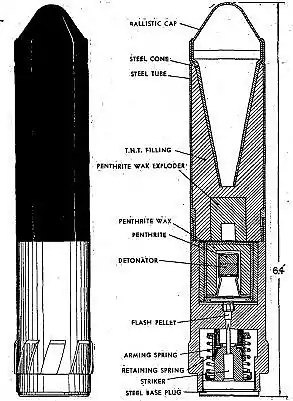Gewehr-Panzergranate
The Gewehr-Panzergranate was a shaped charge rifle grenade that was developed by Germany and used by the Wehrmacht during World War II.
| Gewehr-Panzergranate | |
|---|---|
 A schematic of components. | |
| Type | Shaped charge rifle grenade |
| Place of origin | |
| Service history | |
| Used by | Wehrmacht |
| Wars | World War II[1] |
| Specifications | |
| Mass | 250 g (8.8 oz) |
| Length | 160 mm (6.4 in) |
| Diameter | 30.16 mm (1.1875 in) |
| Muzzle velocity | 50 m/s (160 ft/s)[2] |
| Maximum firing range | 46–114 m (50–125 yd)[1] |
| Warhead | TNT |
| Warhead weight | 50 g (1.75 oz) |
Detonation mechanism | PETN Base fuze[1] |
| Blast yield | 25–30 mm (0.98–1.18 in) RHA[2] |
Design
.png.webp)
The Gewehr-Panzergranate was launched from a Gewehrgranatengerät or Schiessbecher ("shooting cup") on a standard service rifle by a blank cartridge. The primary components were a nose cap, internal steel cone, steel upper body, aluminum lower body, rifled driving band, TNT filling, and a PETN base fuze.[1]
The Gewehr-Panzergranate was an anti-armor weapon which upon hitting the target ignited the PETN base fuze which in turn ignited the TNT filling which collapsed the internal steel cone to create a superplastic high-velocity jet to punch through enemy armor.[1] Since shaped charge weapons rely on chemical energy to penetrate enemy armor the low velocity of the grenade did not adversely affect penetration. A downside of the Gewehr-Panzergranate was its short range 46–114 m (50–125 yd).[2]
References
- unknown (1 August 1945). Catalog Of Enemy Ordnance Material. www.paperlessarchives.com/FreeTitles/CatalogOfEnemyOrdnanceMateriel.pdf: Office of the chief of ordnance. p. 317.
- Natzvaladze, Yury (1996). The Trophies Of The Red Army During The Great Patriotic War 1941–1945. Volume 1. Scottsdale, Arizona: Land O'Sun Printers. p. 44. ASIN B001J7LCD2.